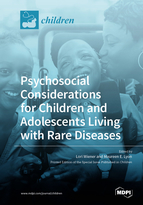Psychosocial Considerations for Children and Adolescents Living with Rare Diseases
A special issue of Children (ISSN 2227-9067).
Deadline for manuscript submissions: closed (15 April 2022) | Viewed by 29448
Special Issue Editors
Interests: pediatric cancer; pediatric HIV/AIDS; psychosocial oncology; psychosocial studies; therapeutic resources; support; distress screening; advance care planning; adolescents; young adults; remove support
Special Issues, Collections and Topics in MDPI journals
Interests: adolescents; advance care planning; patient education; HIV; health outcomes; chronic disease management; evidence based medicine; health inequality; health disparities; health equity
Special Issue Information
Dear Colleagues,
Living with a long-term medical condition, particularly if it is a rare disease, can have a profound impact on the lives of children and their caregivers.
This Special Issue will explore the psychosocial needs of children and adolescents living with a rare condition and interventions that have been developed to address their needs. We are also interested in research conducted to assess the needs of their family members. Our goal is to update readers on evolving research in the field and familiarize them with useful clinical knowledge and interventions. We invite manuscripts addressing the diverse psychosocial, neuropsychological, and educational needs these children face as well as the impact on their family, friends and community. Help to make this collection even more successful by alerting other experts in the field who could submit their own articles. Simply copy and send the following link to your colleagues:
https://0-www-mdpi-com.brum.beds.ac.uk/journal/children/special_issues/psychosocial_considerations
The submission deadline for this Special Issue is 28 February 2022.
Children is an international, peer-reviewed, open access journal of pediatrics, focusing on the dissemination of clinical, epidemiological and translational science relevant to children’s health, published monthly online by MDPI.
High Visibility: indexed within Scopus, SCIE (Web of Science), PubMed, PMC, and many other databases.
5-Year Impact Factor: 3.091 (2020)
Dr. Lori Wiener
Dr. Maureen E. Lyon
Guest Editors
Manuscript Submission Information
Manuscripts should be submitted online at www.mdpi.com by registering and logging in to this website. Once you are registered, click here to go to the submission form. Manuscripts can be submitted until the deadline. All submissions that pass pre-check are peer-reviewed. Accepted papers will be published continuously in the journal (as soon as accepted) and will be listed together on the special issue website. Research articles, review articles as well as short communications are invited. For planned papers, a title and short abstract (about 100 words) can be sent to the Editorial Office for announcement on this website.
Submitted manuscripts should not have been published previously, nor be under consideration for publication elsewhere (except conference proceedings papers). All manuscripts are thoroughly refereed through a single-blind peer-review process. A guide for authors and other relevant information for submission of manuscripts is available on the Instructions for Authors page. Children is an international peer-reviewed open access monthly journal published by MDPI.
Please visit the Instructions for Authors page before submitting a manuscript. The Article Processing Charge (APC) for publication in this open access journal is 2400 CHF (Swiss Francs). Submitted papers should be well formatted and use good English. Authors may use MDPI's English editing service prior to publication or during author revisions.
Keywords
- rare conditions
- rare diseases
- children
- adolescents
- psychosocial
- emotional
- psychological
- neuropsychological







